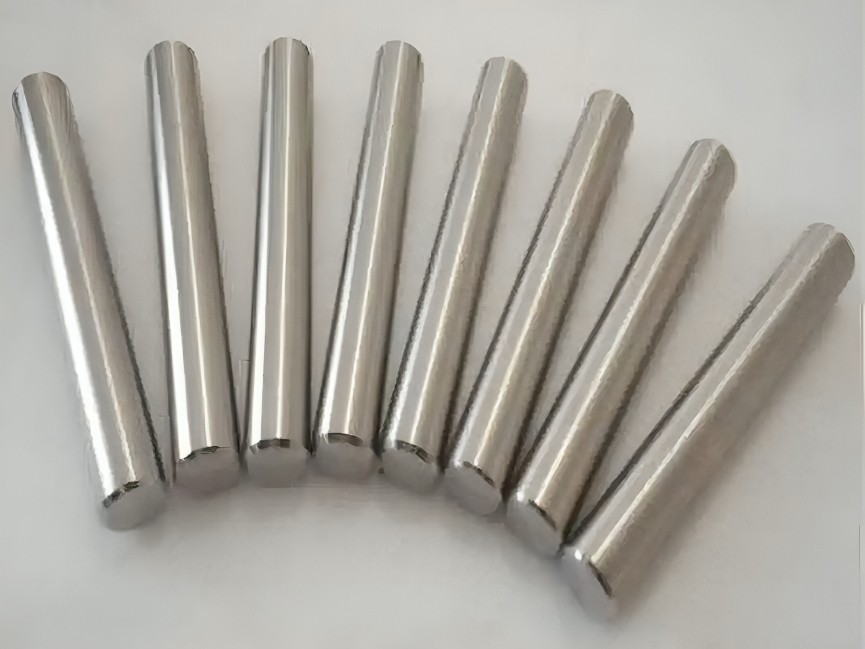
4J29 Expansion Alloy
4J29 alloy, also known as Kovar alloy, has a linear expansion coefficient similar to that of borosilicate glass within the range of 20–450°C. It has a high Curie point and excellent low-temperature structural stability. The alloy forms a dense oxide layer, which allows for effective glass wetting and is resistant to mercury, making it suitable for use in mercury-containing discharge instruments. 4J29 is the primary sealing material used in the structural components of electric vacuum devices.

Standard Dimensions of 4J29 Expansion Alloy in Various Forms
| Form | Thickness / Diameter | Width | Length |
|---|---|---|---|
| 4J29 Expansion Alloy Sheets | 0.3 mm – 5 mm | 100 mm – 1000 mm | 500 mm – 2000 mm |
| 4J29 Expansion Alloy Plates | 5 mm – 50 mm | 200 mm – 1200 mm | 500 mm – 3000 mm |
| 4J29 Expansion Alloy Round Bars | 3 mm – 150 mm diameter | – | 1000 mm – 6000 mm |
| 4J29 Expansion Alloy Flat Bars | 3 mm – 50 mm thickness | 20 mm – 200 mm | 1000 mm – 3000 mm |
| 4J29 Expansion Alloy Wires | 0.1 mm – 10 mm diameter | – | Coil or custom lengths |
| 4J29 Expansion Alloy Tubes | 1 mm – 50 mm outer diameter | – | 500 mm – 3000 mm |
Chemical composition of 4J29
| Element | Content (%) |
|---|---|
| Nickel (Ni) | 28.5 – 29.5 |
| Cobalt (Co) | 16.8 – 17.8 |
| Iron (Fe) | Balance |
| Manganese (Mn) | 0.50 max |
| Silicon (Si) | 0.20 – 0.30 |
| Carbon (C) | 0.03 max |
| Phosphorus (P) | 0.020 max |
| Sulfur (S) | 0.020 max |
| Chromium (Cr) | 0.20 max |
| Molybdenum (Mo) | 0.20 max |
Corresponding and Similar Grades to 4J29 Expansion Alloy
| Standard | Grade | Description |
|---|---|---|
| China (GB/T) | 4J29 | Standard Chinese designation for Kovar alloy |
| USA (ASTM) | Kovar, UNS K94610 | Nickel-cobalt-iron alloy with low thermal expansion |
| Germany (DIN) | W.Nr 1.3981 | Equivalent low-expansion alloy for glass sealing |
| Japan (JIS) | Alloy 29-17 (KV-1) | Low-expansion alloy similar to Kovar for glass compatibility |
| France (AFNOR) | Fe-Ni29Co17 | Low-expansion alloy matching Kovar specifications |
| UK (BS) | Nilo K | Low-expansion alloy for sealing applications |

Our company maintains strong cooperative relationships with many well-known domestic enterprises, such as Taigang (TISCO) and JISCO. We have advanced technology and production equipment, and our metal products have passed international quality standard certifications.(SGS ISO 9001)

We offer a wide variety of alloy products to meet your diverse needs. You can choose from different shapes and grades of alloys. With a large inventory of metal products, we can quickly fulfill your order requirements.

Huaxiao Alloy is a trusted alloy metel supplier. Our team provides full support from pre-sales to after-sales services. Our 24/7 customer service ensures that your needs are always taken care of. We are here to solve any issues related to your alloy material requirements at any time!
Physical Properties of 4J29 Alloy
- Density: 8.5 g/cm³
- Electrical Resistivity: ρ = 0.48 μΩ·m
- Curie Point: Tc = 430°C
- Magnetic Properties: Under a magnetic field of 4000 A/m, 4J29 alloy has a residual magnetic induction Br=0.98 TBr = 0.98 \, TBr=0.98T and a coercive force Hc=68.8 A/mHc = 68.8 \, A/mHc=68.8A/m.
- Elastic Modulus: E = 138 GPa
Structure and Melting Process of 4J29 Alloy
Microstructure of 4J29 Alloy
After heat treatment as specified in 1.5, and subsequently frozen at -78.5°C for a minimum of 4 hours, 4J29 alloy should not exhibit martensitic structure. However, if the alloy composition is improper, transformation from austenite (γ) to needle-like martensite (α) can occur at ambient or low temperatures. This transformation causes volume expansion, increasing the alloy’s expansion coefficient and potentially leading to significant internal stresses within sealed components, sometimes causing partial damage. The primary factor affecting the alloy’s low-temperature structural stability is its chemical composition. Nickel is the main element stabilizing the γ-phase, with higher nickel content favoring its stability. Structural stability improves with the alloy’s total deformation rate, while composition segregation may result in local γ→α transformations. Additionally, coarser grains can promote this transformation.Grain Size of 4J29 Alloy
For deep-drawn strips, the standard specifies a grain size of no less than grade 7, with grains smaller than grade 7 not exceeding 10% of the total area. For strips thinner than 0.13 mm, the average grain size should include at least eight grains along the strip thickness direction.Melting and Casting Process of 4J29
4J29 alloy can be melted using a non-vacuum induction furnace, vacuum induction furnace, or electric arc furnace.
Application Areas of 4J29 Alloy
- Suitable for use in instruments containing mercury discharge.
- Used as the primary sealing material in the structure of electric vacuum devices.
Thermal Expansion Compatibility
4J29 is designed to match the thermal expansion coefficient of borosilicate glass within the range of 20–450°C, allowing for reliable glass-to-metal sealing. This compatibility is essential in high-vacuum environments, ensuring the integrity and longevity of the seal in devices exposed to varying temperatures.
Oxidation Resistance and Glass Wetting
The alloy forms a dense and stable oxide layer, enhancing its compatibility with glass. This oxide layer allows the glass to bond tightly with the alloy, ensuring a strong seal. The alloy’s resistance to oxidation further improves its durability in vacuum applications.
Airtightness and Stability in Mercury Environments
4J29 is resistant to mercury, making it suitable for devices that operate in mercury-containing environments, such as certain discharge tubes. This resistance helps prevent degradation of the material in applications where mercury exposure is a factor.
Machinability and Heat Treatment
- Machinability: 4J29 alloy is relatively easy to machine, making it suitable for precise manufacturing of small components required in electrical and electronic devices.
- Heat Treatment: Proper heat treatment is crucial to achieve low expansion and stable structural properties. Heat treatment processes, such as stress-relief annealing and stabilization aging, help maintain mechanical properties and dimensional accuracy after machining.
Vacuum and Non-Vacuum Melting Techniques
The alloy can be melted using various methods, including vacuum induction, non-vacuum induction, and electric arc furnaces. Each method offers advantages depending on specific application requirements, with vacuum melting generally preferred for high-purity and high-performance applications.
Grain Structure Control
To ensure stability in deep-drawing applications, 4J29 alloy requires controlled grain size, particularly for strip forms used in sensitive electronic applications. Standard requirements dictate a minimum grain size for deep-drawn products to maintain consistency and reduce the risk of defects in thin sections.



